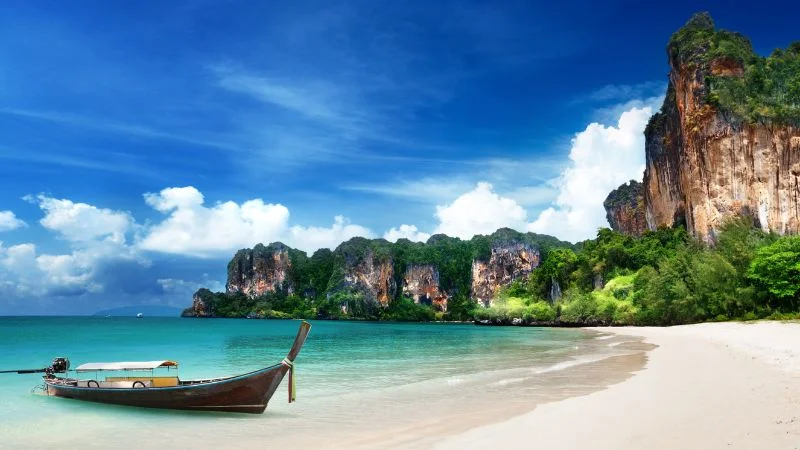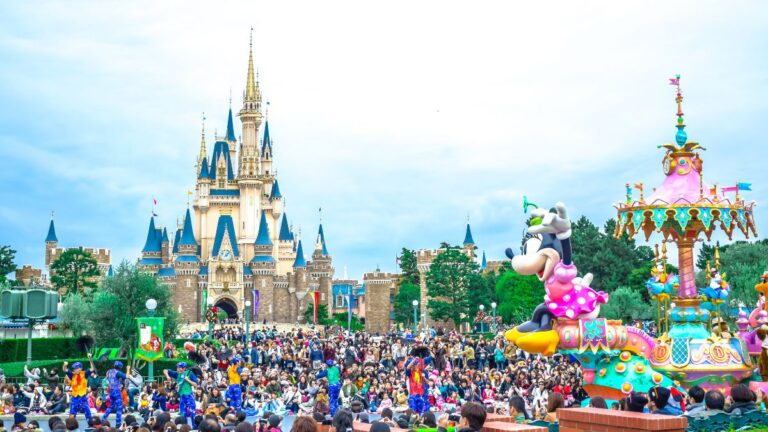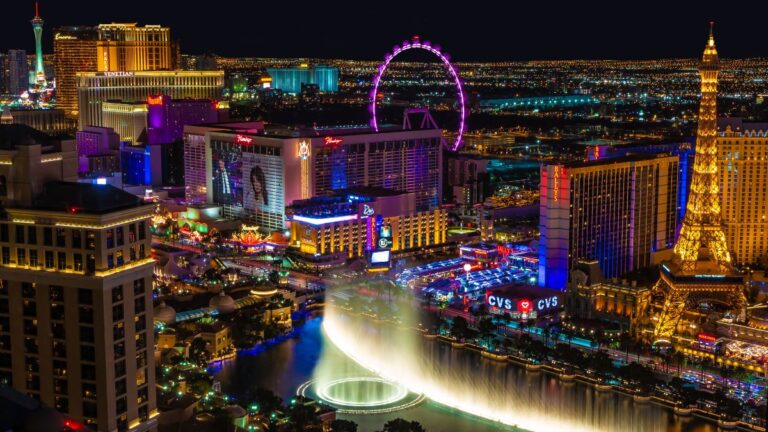50 Facts About Thailand You Need to Know Before Traveling There

As participants in Amazon Associates and other programs, we earn from qualifying purchases. This comes at no additional cost to you. For more details, see our Affiliate Disclosure.
Beneath the shimmering surface of its azure seas and beyond the bustling streets of Bangkok lies a realm brimming with marvels waiting to be discovered. Thailand, a land of diverse landscapes, rich traditions, and mouthwatering cuisine, beckons travelers with its enigmatic charm and vibrant culture. Whether you’re drawn by the allure of serene temples, the wild beauty of its rainforests, or the warmth of its people, understanding the heart and soul of this magnificent country is essential before setting foot on its soil. In this comprehensive guide, we unveil 50 essential facts about Thailand, offering you a treasure trove of insights to enrich your journey and ensure you experience the Land of Smiles in all its glory. Prepare to embark on an unforgettable adventure as we explore everything from its historical enigmas to contemporary quirks, ensuring you’re well-informed and ready to dive into the Thai experience.
The Land of Free
Thailand, known as “The Land of Free,” stands unique as the only Southeast Asian nation never colonized by European powers. This cherished sovereignty shapes its national identity, fostering a strong sense of pride among its people. The country’s name itself, “Prathet Thai,” means “land of the free,” a testament to its enduring independence. Thailand’s rich cultural landscape, influenced by ancient traditions and its position as a crossroads of Eastern civilizations, thrives without the direct imprint of Western colonization, offering a deeply rooted sense of heritage and identity that continues to captivate and enchant visitors from around the globe.
A Kingdom with a Rich History
Thailand’s narrative is a tapestry of kings, conflicts, and civilizations that have sculpted its landscape over millennia. From the ancient kingdoms of Sukhothai and Ayutthaya to the modern era of the Chakri dynasty, Thailand’s history is a vivid reflection of resilience, spirituality, and transformation. Each period left indelible marks on the nation’s cultural and physical geography, from majestic ruins and temples to the very essence of Thai social norms and royal traditions. The kingdom’s history is not just a relic of the past but a living part of its present, influencing everything from governance to daily life.
The Spiritual Heartland: Buddhism in Thailand
Buddhism is the soul of Thailand, weaving through the fabric of Thai life and culture with serene temples and golden Buddhas. Nearly 95% of Thais practice Theravada Buddhism, which influences everything from art and architecture to festivals and daily routines. Temples, or ‘wats,’ serve as community centers, schools, and places of worship, highlighting the religion’s integral role in societal cohesion. The spiritual landscape of Thailand is one of mindfulness and morality, underscored by Buddhist principles that guide social conduct and the nation’s approach to peace and hospitality.
A Culinary Odyssey: Thai Cuisine
Thai cuisine is a vibrant celebration of taste, color, and texture, offering an endless odyssey of flavors that range from fiery spicy to subtle sweetness. Influenced by Chinese, Indian, and Malay culinary traditions, Thai food is a testament to the country’s ability to assimilate diverse influences into something uniquely its own. Dishes like Pad Thai, Green Curry, and Som Tum (Papaya Salad) have captivated palates worldwide, but they merely scratch the surface of Thailand’s culinary diversity. Each region boasts its specialties, from the coconut-rich curries of the south to the earthy, aromatic dishes of the north, making every meal in Thailand an adventure in itself.
The Festival of Water: Songkran
Songkran, the Thai New Year festival, is an exuberant celebration that marks the beginning of the Buddhist New Year in April. Known internationally as the Water Festival, Songkran involves the splashing of water as a symbol of washing away negativity and bad luck. The festival has deep-rooted cultural and religious significance, incorporating rituals such as offering food to Buddhist monks and paying respects to elders. Songkran is not only a time for reflection but also one of the world’s biggest water fights, showcasing Thailand’s community spirit and joyous approach to life’s renewal.
Majestic Elephants: Thailand’s National Symbol
The elephant holds a place of honor in Thailand, symbolizing strength, wisdom, and royalty. Historically, these majestic creatures were integral to warfare, labor, and the royal emblem, embodying the nation’s dignity and grandeur. Today, Thailand’s reverence for elephants continues, with conservation efforts and sanctuaries highlighting the shift towards ethical treatment and preservation. Elephants are celebrated annually on National Elephant Day, reflecting ongoing respect and love for these gentle giants, which are an indelible part of the Thai heritage and consciousness.
The Tropical Paradise of Islands and Beaches
Thailand’s islands and beaches are the stuff of dreams, offering a slice of paradise with their crystal-clear waters, powdery sands, and lush palm groves. Destinations like Phuket, Koh Samui, and the Phi Phi Islands are renowned for their breathtaking beauty, vibrant marine life, and the range of activities they offer, from snorkeling and scuba diving to simply soaking up the sun. Each island has its unique charm, promising serene retreats and adventure alike, and epitomizing the natural allure that makes Thailand a top destination for beach lovers worldwide.
A Haven for Street Food Enthusiasts
The streets of Thailand are a culinary playground, where the aromas of grilled meats, fresh herbs, and spicy sauces mingle in the air. Street food is an essential part of Thai culture, offering a taste of the country’s diverse culinary landscape at every corner. From bustling markets in Bangkok to quiet stalls in Chiang Mai, the variety is endless. Favorites include Pad Thai, grilled satays, and mango sticky rice, all delivering mouthwatering flavors at an affordable price. This vibrant street food scene not only satisfies the palate but also provides a window into the communal and lively spirit of Thai life.
The Grandeur of Thai Temples: Wats
The spiritual landscape of Thailand is dotted with over 40,000 temples, or ‘wats,’ serving as the heart of Buddhist practice and community life. These sacred sites range from humble village chapels to grand royal temples, each with its own history and architectural beauty. Iconic temples such as Wat Phra Kaew in Bangkok and Wat Pho, home of the Reclining Buddha, are not just places of worship but also repositories of art, history, and culture. The grandeur of Thai temples, with their intricate designs and golden spires, reflects the deep reverence for Buddhism and its role in shaping the Thai identity.
The Thai New Year Celebration: Loy Krathong
Loy Krathong, celebrated on the evening of the full moon of the 12th month in the traditional Thai lunar calendar, is a picturesque festival that pays homage to the water spirits. Participants release lotus-shaped rafts, or ‘krathongs,’ made of banana leaves and adorned with candles, incense, and flowers, into rivers and lakes. This serene and beautiful tradition symbolizes the letting go of grudges, anger, and defilements, allowing Thais to start anew with hope and happiness. The sight of thousands of flickering lights floating on waterways is a magical experience, capturing the essence of Thai culture’s reflective and joyful nature.
The Lush Landscapes of Northern Thailand
Northern Thailand is a region of breathtaking natural beauty, characterized by rolling hills, dense forests, and serene countryside. This area offers a stark contrast to the bustling cities and tropical beaches elsewhere in the country, presenting a peaceful retreat into nature. Chiang Mai, the cultural heart of the north, serves as a gateway to this verdant landscape, offering access to national parks like Doi Inthanon and the picturesque Pai Valley. The region’s rich cultural tapestry, influenced by the Lanna Kingdom and hill tribe communities, adds depth to its natural allure, making Northern Thailand a must-visit for those seeking tranquility and a connection to traditional Thai ways of life.
Bangkok: The City of Angels
Bangkok, known in Thai as Krung Thep which means ‘City of Angels,’ is the vibrant capital and the pulsating heart of Thailand. A city of contrasts, Bangkok merges the traditional with the ultra-modern, offering an exhilarating mix of historic temples, bustling markets, towering skyscrapers, and vibrant nightlife. From the sacred grounds of the Grand Palace and Wat Pho to the shopping meccas of Siam and Chatuchak Weekend Market, Bangkok invites exploration and discovery at every turn. The city’s bustling streets, flowing canals, and the warmth of its people embody the dynamic spirit of Thailand, making Bangkok a microcosm of the country’s diverse charms.
Thai Massage: A Healing Art
Thai massage, an ancient healing system combining acupressure, Indian Ayurvedic principles, and assisted yoga postures, is a signature therapeutic art of Thailand. Known for its vigorous and energizing techniques, Thai massage is often referred to as “lazy yoga,” providing the benefits of yoga practice without any work on the part of the recipient. This practice, deeply rooted in Buddhist teaching, is not merely a form of relaxation but a holistic approach to healing, designed to improve physical flexibility, boost energy levels, and balance the body’s energy systems. Offered everywhere from traditional temples to beachside huts, experiencing a Thai massage is a quintessential part of the Thailand visit, embodying the country’s holistic approach to health and well-being.
The Vibrant Night Markets of Thailand
Thailand’s night markets are a kaleidoscope of sights, sounds, and smells, offering an immersive experience into the country’s lively street culture. These markets, found in cities and towns across Thailand, come alive after dark, offering everything from street food and drinks to clothing, handicrafts, and entertainment. Places like the Chiang Mai Night Bazaar and Bangkok’s Asiatique combine shopping with cultural performances, making them popular among locals and tourists alike. Exploring a Thai night market is an adventure in itself, providing a taste of local life, opportunities to find unique souvenirs, and the chance to indulge in some of the best street food in the world.
The Legendary Full Moon Party
The Full Moon Party on Koh Phangan has become legendary, attracting thousands of revelers to Haad Rin Beach each month to celebrate under the light of a full moon. What started as a small gathering of friends has evolved into a global phenomenon, featuring DJs, fire dancers, and a myriad of bars along the beach. The party is synonymous with all-night dancing, vibrant neon paint, and a spirit of freedom and festivity. While it’s a must-experience for party-goers, the Full Moon Party also reflects Thailand’s broader appeal to international visitors, offering a unique blend of natural beauty and cultural festivity.
Tuk-Tuks: Thailand’s Iconic Three-Wheelers
Tuk-tuks, the iconic three-wheeled motorized rickshaws, are synonymous with Thailand’s bustling urban landscapes. These nimble vehicles zip through the narrow alleys and crowded streets, offering a thrilling and quintessentially Thai mode of transport. Their colorful exteriors and the energetic demeanor of their drivers add to the charm and vibrancy of Thai city life. Riding in a tuk-tuk is not just a means to get from point A to B; it’s an adventure and a must-do experience for visitors, encapsulating the dynamic and spirited essence of Thailand’s urban centers.
The Majestic Beauty of Thai Silk
Thai silk, known for its exquisite quality and vibrant colors, is a symbol of Thai craftsmanship and tradition. The production of Thai silk begins with the cultivation of silk worms and involves a meticulous and labor-intensive process that results in a fabric of unparalleled softness and luster. Jim Thompson, an American who revitalized the Thai silk industry in the mid-20th century, played a significant role in introducing Thai silk to the world stage. Today, Thai silk is celebrated for its distinctive patterns and durability, making it a sought-after material for garments and home décor, and a beautiful representation of Thailand’s rich artistic heritage.
The World-Renowned Thai Hospitality
Thai hospitality is legendary, embodying the warmth and generosity of its people. Thailand’s culture places a high value on kindness and respect, often encapsulated in the Thai phrase, “Land of Smiles.” Visitors are greeted with a graciousness that makes them feel welcome and valued, whether they’re staying in a luxury resort or a humble guesthouse. This hospitality extends beyond mere politeness, reflecting a deep-rooted belief in the importance of making guests feel at home. It’s this genuine warmth and friendliness that leaves a lasting impression on travelers, contributing to Thailand’s reputation as a top travel destination.
Muay Thai: The Art of Eight Limbs
Muay Thai, Thailand’s national sport, is known as “the art of eight limbs” because it utilizes punches, kicks, elbows, and knee strikes, making it one of the most comprehensive striking martial arts. Rooted in ancient battlefield tactics, Muay Thai has evolved into a popular competitive sport and form of exercise worldwide. Training camps and gyms throughout Thailand welcome practitioners of all levels, from novices to professional fighters, reflecting the sport’s ingrained position in Thai culture. Muay Thai is not just a sport but a discipline that teaches respect, perseverance, and mental toughness, mirroring the spirit and values of the Thai people.
The Enigmatic Ruins of Ayutthaya
The ancient city of Ayutthaya, once the flourishing capital of the Kingdom of Ayutthaya, stands today as a poignant reminder of Thailand’s rich historical tapestry. Founded in 1350, Ayutthaya was a hub of global diplomacy and commerce until it was tragically razed by the Burmese in the 18th century. Now a UNESCO World Heritage site, its ruins, including towering temples and palaces, evoke the grandeur of a bygone era. Exploring Ayutthaya offers a glimpse into the splendor of ancient Siam, where art, culture, and architecture converged, making it an essential pilgrimage for those seeking to understand Thailand’s complex past and enduring spirit.
Thailand’s Love Affair with Motorbikes
In Thailand, motorbikes are more than just a mode of transport; they are a way of life. The country’s streets buzz with the sound of scooters, serving as the backbone of daily transportation for millions. This love affair with two-wheelers is driven by the convenience, affordability, and freedom they offer, allowing riders to navigate the bustling urban landscapes and serene rural areas alike. For tourists, renting a motorbike can unlock the country’s hidden treasures, providing a sense of adventure and an intimate look at Thai life beyond the typical tourist routes.
The Colorful Underwater World of Diving Sites
Thailand’s marine landscapes are as diverse and vibrant as the country itself, boasting some of the world’s most renowned diving sites. From the coral gardens of the Similan Islands to the dramatic underwater topography of Koh Tao, Thailand offers underwater adventures for divers of all levels. The warm, clear waters are teeming with life, including a kaleidoscope of tropical fish, majestic manta rays, and elusive whale sharks, providing an unparalleled opportunity to connect with the natural world in a truly immersive way. Diving in Thailand is not just a sport but a celebration of the country’s stunning aquatic biodiversity.
Thai Iced Tea: A Refreshing Beverage
Thai iced tea, with its distinctive orange color and sweet, creamy taste, is a quintessential Thai beverage that has gained popularity worldwide. Made from strongly brewed Ceylon tea, sweetened with sugar and condensed milk, and served over ice, this refreshing drink is a staple in Thai restaurants and street food stalls. Its rich flavor and cooling effect provide welcome relief from Thailand’s tropical heat, making it the perfect accompaniment to the spicy flavors of Thai cuisine. Thai iced tea embodies the balance and harmony that characterize Thai culinary traditions, blending the bold and the delicate into a delightful sensory experience.
The Monarchy’s Revered Status in Thai Society
The monarchy holds a revered and central place in Thai society, embodying the nation’s identity, unity, and continuity. The Thai people hold deep respect for the Royal Family, a sentiment rooted in centuries of history and tradition. The King of Thailand is not only a head of state but also a moral leader and a symbol of the nation’s stability and heritage. Important ceremonies and festivals often involve the monarchy, reflecting its integral role in the cultural and spiritual life of the country. The reverence for the monarchy is evident in the ubiquitous portraits of the Royal Family displayed throughout the country, symbolizing the people’s affection and respect.
The Complex Flavors of Thai Curry
Thai curry represents the essence of Thai cuisine, with its complex interplay of flavors, colors, and textures. Unlike their Indian counterparts, Thai curries blend the heat of chili peppers with the creaminess of coconut milk, the tang of lime leaves, and the umami of fish sauce, creating a rich and layered culinary experience. Varieties such as green, red, yellow, and massaman curry each offer a unique taste profile, reflecting the diversity of Thailand’s regional ingredients and culinary influences. Thai curry is more than just a dish; it’s a testament to the country’s rich cultural mosaic and its people’s mastery of balancing the five fundamental flavors.
The Tradition of Wai: A Thai Greeting
The “wai” is a traditional Thai greeting that embodies the culture’s emphasis on respect and courtesy. Performed by pressing the palms together at chest or nose level and bowing slightly, the wai is more than a simple hello; it’s a sign of respect and a way to acknowledge someone’s presence and dignity. The gesture varies in formality depending on the social status and relationship between the people involved, serving as a nuanced form of communication within Thai society. This elegant and meaningful greeting captures the essence of Thai etiquette, prioritizing harmony, respect, and social cohesion.
The Mysterious Hill Tribes of the North
Northern Thailand is home to a mosaic of ethnic groups known collectively as the hill tribes, each with its distinct language, traditions, and way of life. These communities, including the Karen, Hmong, Akha, and Lisu, live in harmony with the rugged, mountainous landscape that characterizes the region. Visiting these villages offers a window into a way of life that has remained largely unchanged for centuries, characterized by traditional farming practices, rich textile traditions, and spiritual beliefs deeply connected to the natural world. The hill tribes contribute to Thailand’s cultural diversity, adding another layer of richness to the nation’s identity.
Thailand’s Commitment to Sustainability
As one of Southeast Asia’s most visited destinations, Thailand faces the challenges of balancing tourism development with environmental preservation. In recent years, the country has demonstrated a growing commitment to sustainability, implementing measures to protect its natural landscapes, wildlife, and marine environments. Efforts include the establishment of marine national parks, bans on single-use plastics in tourist areas, and initiatives to promote eco-tourism. These actions reflect Thailand’s recognition of its natural heritage as a precious resource, not only for its economic value but also for its importance to the country’s identity and future.
The Bustling Floating Markets
Thailand’s floating markets offer a glimpse into a traditional way of life that has thrived along the country’s waterways for centuries. These markets, with vendors selling fresh produce, cooked foods, and handicrafts from boats and along the riverbanks, are a vibrant testament to Thailand’s rich cultural heritage. The most famous of these, Damnoen Saduak, along with others like Amphawa and Taling Chan, provide colorful and bustling scenes, drawing visitors eager to experience the lively atmosphere and to capture a piece of Thailand’s history. Floating markets are not just tourist attractions; they’re living museums, showcasing the enduring importance of Thailand’s rivers and canals to its people’s way of life.
Thai Festivals: A Spectacle of Culture
Thai festivals are a vibrant tapestry of culture, color, and tradition, encapsulating the spirit and heritage of the country. From the water-soaked revelries of Songkran to the serene beauty of Loy Krathong, these celebrations are deeply rooted in Thai history and spirituality. Festivals like the Yi Peng Lantern Festival in Chiang Mai, where thousands of lanterns illuminate the night sky, create mesmerizing sights that embody the country’s fascination with light and spirituality. These events offer a glimpse into the communal spirit of the Thai people, showcasing traditions that have been passed down through generations, and providing unforgettable experiences for both locals and visitors alike.
The Resplendent Beauty of Thai Orchids
Thailand is renowned for its orchids, the resplendent blooms that are a symbol of tropical beauty and exotic allure. The country’s climate and geography make it an ideal habitat for these delicate flowers, which are celebrated for their diverse shapes, sizes, and vibrant colors. Orchids hold a special place in Thai culture, used in everything from ornamental decoration to traditional ceremonies. The Thai orchid industry is also a significant part of the global flower market, exporting these beautiful blooms worldwide. A visit to an orchid farm or a local market in Thailand offers a chance to witness the stunning diversity and beauty of these flowers, showcasing yet another facet of the country’s natural wealth.
The Intricacies of Thai Language and Script
The Thai language, with its own unique script and tonal nuances, is the heart of Thailand’s cultural identity. The alphabet, derived from ancient scripts of India, comprises 44 consonants and 15 vowel symbols that combine to form 28 vowel forms. Thai is a tonal language, meaning the pitch or tone used when a word is spoken can change its meaning. This linguistic complexity reflects the intricate nature of Thai culture and its historical influences. Learning even a few basic phrases can enrich a visitor’s experience, opening up a deeper connection with the people and the traditions of Thailand.
The Enchanting Northern Lights of Thailand: The Naga Fireballs
The Naga Fireballs are a mysterious and enchanting natural phenomenon that occurs annually along the Mekong River in northeastern Thailand. According to local folklore, these glowing orbs are the breath of the Naga, a mythical serpent creature. The fireballs rise from the river into the night sky, usually around the end of the Buddhist Lent in October. This spectacle draws crowds of spectators and is accompanied by a festival celebrating the legend of the Naga. While scientists offer explanations such as the spontaneous combustion of swamp gases, for many, the Naga Fireballs remain a magical display that connects the natural world with the realm of myth and legend.
The Unique Wildlife of Thailand’s Jungles
Thailand’s lush jungles and national parks are teeming with a diverse array of wildlife, offering a sanctuary for hundreds of species, including elephants, tigers, gibbons, and exotic birds. The country’s commitment to conservation has led to the establishment of numerous protected areas, where visitors can experience Thailand’s wild side through eco-tourism and responsible travel. Adventures in parks like Khao Yai or the jungles of Chiang Mai provide not only the thrill of spotting rare animals in their natural habitat but also the awareness of the importance of preserving these precious ecosystems for future generations.
The Iconic Longtail Boats
Longtail boats, with their distinctive narrow design and elongated propeller shafts, are an iconic feature of Thailand’s maritime landscape. These versatile vessels navigate the country’s myriad waterways, from the bustling canals of Bangkok to the serene beaches and islands of the Andaman Sea. Longtails provide a vital link between remote areas, offering a unique way to explore Thailand’s stunning coastal and riverine environments. Riding in a longtail boat, with its engine’s rhythmic hum and the splash of water, offers an authentic experience of Thai life, connecting the timeless tradition of river travel with the beauty of the country’s natural surroundings.
The Lure of Thai Street Art and Graffiti
In recent years, Thailand has become a canvas for street artists, with Bangkok, Chiang Mai, and other cities showcasing vibrant graffiti and murals that offer social commentary, celebrate Thai culture, or simply add beauty to urban environments. Areas like the Bangkok Art and Culture Centre and the streets of Talat Noi in the capital have become hubs for creative expression, drawing both local and international artists. This burgeoning street art scene not only enhances the urban landscape but also creates a dialogue between tradition and modernity, reflecting Thailand’s evolving cultural identity in the 21st century.
The Charming Old Towns and Their History
Thailand’s old towns, such as Phuket Old Town and Chiang Mai’s Old City, are charming windows into the country’s past, offering a glimpse of life in times gone by. These historic districts, with their Sino-Portuguese architecture, ancient temples, and traditional shophouses, tell the stories of Thailand’s diverse cultural influences and rich history. Strolling through these areas, visitors can admire the intricate details of the buildings, explore local markets, and enjoy traditional Thai dishes. The preservation of these old towns reflects Thailand’s respect for its heritage, providing a tangible link to the past amid the modernity of contemporary life.
Thailand’s Role in the Global Film Industry
Thailand has made a significant impact on the global film industry, both as a picturesque location for international productions and through its own vibrant cinema. The country’s stunning landscapes, from the bustling streets of Bangkok to the tranquil beaches of Krabi, have provided the backdrop for countless films, attracting filmmakers with their beauty and diversity. Meanwhile, Thai cinema has gained international acclaim for its compelling storytelling and innovative direction, with directors like Apichatpong Weerasethakul winning prestigious awards. Thailand’s film industry showcases the country’s cultural richness and creativity, contributing to its global recognition as a center of artistic expression.
The Piquant Pleasure of Thai Snacks
Thai snacks, with their bold flavors and inventive combinations, are a testament to the country’s love affair with food. From spicy, sour, sweet, to salty, these snacks range from street food staples like satay and spring rolls to innovative treats such as coconut ice cream served in a coconut shell. Thailand’s snack culture extends beyond traditional recipes, incorporating modern and international influences that cater to a diverse palate. Sampling these snacks offers a quick and delicious insight into the complexity of Thai cuisine, reflecting the country’s ability to blend tradition with innovation.
The Sacredness of the Thai Royal Family
The Thai Royal Family is deeply revered in Thailand, embodying the nation’s unity, heritage, and moral authority. The monarchy’s history is interwoven with the country’s development, playing a crucial role in its political, social, and cultural life. Rituals and ceremonies related to the monarchy, such as the King’s Birthday and Coronation Day, are observed with great reverence, highlighting the profound respect and affection that the Thai people have for their royal institution. This reverence is more than tradition; it’s a reflection of the monarchy’s significance in maintaining the country’s stability and identity.
The Thrill of Muay Thai Stadiums
Muay Thai stadiums are electrifying arenas where the ancient martial art of Muay Thai comes to life. Iconic venues like Lumpinee and Rajadamnern in Bangkok host regular fights, drawing crowds eager to witness the skill, strategy, and sheer physicality of the fighters. The atmosphere in these stadiums is charged with excitement, as spectators cheer on their favorites, experiencing the sport’s raw power and grace up close. For many, attending a Muay Thai match is a highlight of their visit to Thailand, offering a direct connection to a key aspect of Thai culture and an unforgettable display of human resilience and prowess.
The Legendary Thai Puppets: Hun Krabok
Hun Krabok, a traditional Thai puppet theater, is a captivating art form that combines craftsmanship, music, and storytelling. These intricate puppets, operated by skilled puppeteers, bring to life tales from Thai folklore and literature, enchanting audiences with their lifelike movements and expressive performances. The art of Hun Krabok is a testament to Thailand’s rich cultural heritage, showcasing the creativity and narrative tradition that has been passed down through generations. While this art form is rarer today, performances still enchant those fortunate enough to witness them, offering a unique glimpse into Thailand’s artistic soul.
The Intriguing Tradition of Thai Tattoos: Sak Yant
Sak Yant, the traditional Thai tattoo, is a sacred art that dates back centuries, blending spiritual beliefs with ancient tattooing techniques. These intricate designs, inscribed with Buddhist prayers and magical symbols, are believed to offer protection, strength, and good fortune to those who wear them. The practice of Sak Yant, performed by monks and ajarns (master tattooists), is a deeply personal and spiritual experience, reflecting the profound connection between Thai culture and the spiritual world. For many, receiving a Sak Yant tattoo is not just about the physical marking but about embarking on a spiritual journey, embodying the mystical essence of Thai traditions.
The Blossoming Coffee Culture in Thailand
In recent years, Thailand has experienced a blossoming of its coffee culture, with a surge in the popularity of both traditional Thai coffee and specialty cafes. Across the country, from the streets of Bangkok to the mountains of Chiang Rai, coffee shops have become spaces for social interaction, creativity, and the appreciation of high-quality coffee. Thai coffee, known for its strong flavor and often served iced with condensed milk, has been joined by a variety of specialty blends and brewing methods, reflecting the country’s growing passion for coffee. This thriving coffee culture showcases Thailand’s ability to embrace global trends while maintaining its unique culinary traditions.
The Protective Amulets of Thailand
Thai amulets, small Buddhist talismans, are a ubiquitous part of Thai culture, revered for their protective powers and spiritual significance. Crafted from a variety of materials and blessed by monks, these amulets are worn or carried by people from all walks of life, seeking good fortune, health, and protection from harm. The tradition of Thai amulets reflects the deep-rooted influence of Buddhism in Thailand, as well as the local belief in the power of the supernatural. Collecting and trading amulets has also become a popular hobby in Thailand, with some rare amulets highly prized and sought after for their spiritual and monetary value.
The Vital Role of Rice in Thai Cuisine
Rice is not just a staple of Thai cuisine; it is its very foundation, playing a vital role in the country’s culinary and cultural landscape. Thailand is one of the world’s largest producers and exporters of rice, and the grain features prominently in the Thai diet, accompanying almost every meal. From fragrant jasmine rice to sticky rice that’s perfect for dipping into spicy sauces or enjoying with mango, rice is celebrated for its versatility and cultural significance. The annual Royal Ploughing Ceremony highlights the importance of rice cultivation in Thai society, blessing the new planting season and ensuring the prosperity of the coming harvests.
The Captivating Folklore and Myths
Thailand’s rich tapestry of folklore and myths offers a window into the country’s cultural soul, blending elements of Buddhism, Hinduism, and animist beliefs. Tales of ghosts, spirits, and mythical creatures like the Naga snake play a significant role in Thai culture, influencing everything from religious practices to popular media. These stories, passed down through generations, not only entertain but also impart moral lessons and reflect the Thai people’s deep connection to the supernatural world. The enduring popularity of these tales speaks to their importance in shaping Thai identity and understanding of the natural and spiritual worlds.
The Evolution of Thai Fashion
Thai fashion has undergone a significant evolution, from traditional garments like the silk sarong and the intricately woven Pha Sin to the vibrant and diverse fashion scene of today. Bangkok, in particular, has emerged as a fashion hub, hosting international fashion weeks and showcasing local designers who blend traditional Thai elements with modern aesthetics. This fusion of old and new reflects Thailand’s broader cultural dynamics, where respect for tradition coexists with a forward-looking, global perspective. Thai fashion not only expresses individual style but also the country’s cultural richness and creativity.
The Significance of the Thai Elephant Pants
Thai elephant pants, known for their comfort and distinctive patterns featuring elephant motifs, have become a symbol of the tourist experience in Thailand. These loose-fitting trousers are not only a popular souvenir but also a representation of the casual, laid-back lifestyle that many associate with Thailand’s travel culture. While they hold no traditional significance, their popularity among visitors has made them a recognizable aspect of Thailand’s global image, blending the appeal of exotic travel with the practicality of modern, casual wear.
The Impact of Tourism on Thailand
Tourism has had a profound impact on Thailand, shaping its economy, culture, and environment. As one of the world’s top tourist destinations, Thailand welcomes millions of visitors each year, drawn by its stunning landscapes, rich cultural heritage, and renowned hospitality. While tourism has contributed significantly to economic growth and development, it has also presented challenges, including environmental degradation and the commercialization of culture. Recognizing these challenges, Thailand is actively working towards sustainable tourism practices that preserve its natural and cultural assets for future generations, ensuring that the country remains a beloved destination for years to come.






